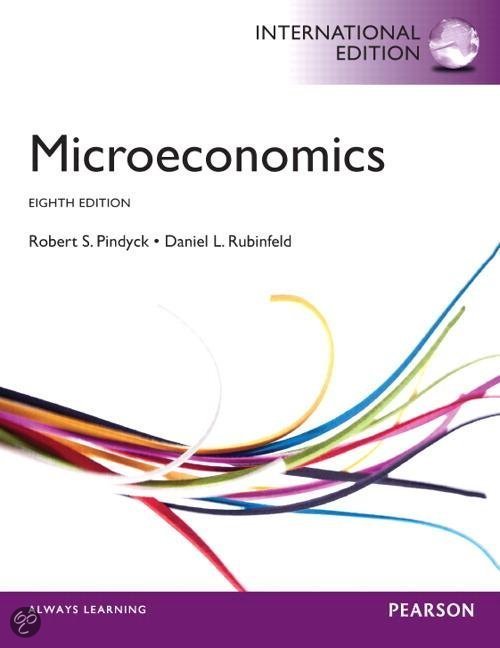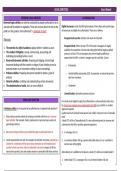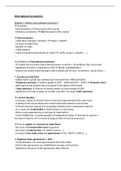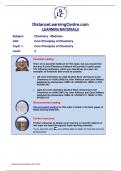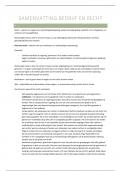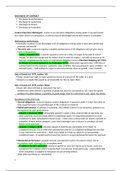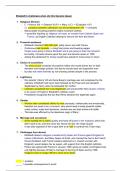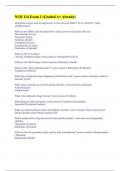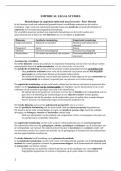Microeconomics Summary
Week 1
1.1 The Themes of Microeconomics
**Microeconomics describes the trade-offs that consumers, workers, and firms face,
and shows how these trade-offs are best made.
In a centrally planned economy, the government sets prices. In a market economy,
prices are determined by the interactions of consumers, workers, and firms.
The theory of the firm begins with a simple assumption – firms try to maximize their
profits. The theory of the firm tells us whether a firm’s output level will increase or
decrease in response to an increase in wage rates or a decrease in the price of raw
materials.
Positive analysis – Analysis describing relationships of cause and effect.
Normative analysis – Analysis examining questions of what ought to be.
1.2 What Is a Market?
Market – Collection of buyers and sellers that, through their actual or potential
interactions, determine the price of a product or set of products.
Industry – A collection of firms that sell the same or closely related products.
Market definition – Determination of the buyers, sellers, and range of products that
should be included in a particular market.
Arbitrage – Practice of buying at a low price at one location and selling at a higher
price in another.
Perfectly competitive market – Market with many buyers and sellers, so that no
single buyer or seller has a significant impact on price.
Market price – Price prevailing in a competitive market.
Extent of a Market – Boundaries of a market, both geographical and in terms of
range of products produced and sold within it.
2.1 Supply and Demand
The supply-demand model combines two important concepts: the supply curve and a
demand curve.
Supply curve – Relationship between the quantity of a good that producers are
willing to sell and the price of the good.
, **The higher the price, the more firms are able
and willing to produce and sell. The quantity
supplied can also depend on production costs,
including wages, interest charges, and the
costs of raw materials.
Movements along the supply curve can
represent changes in price. Changes in
other variables are shown by a shift of the
supply curve itself.
Demand curve – Relationship between the quantity of a good that consumers are
willing to buy and the price of the good.
Substitutes – Two goods for which an increase in the price of one leads to an increase
in the quantity demanded of the other.
Complements – Two goods for which an increase in the price of one leads to a
decrease in the quantity demanded of the other.
2.2 The Market Mechanism
Equilibrium (market-clearing price) – Price that equates the quantity supplied to
the quantity demanded.
Market mechanism – Tendency in a free market for price to change until the market
clears.
Surplus – Situation in which the quantity supplied exceeds the quantity demanded.
Shortage – Situation in which the quantity demanded exceeds the quantity supplied.
,2.4 Elasticities of Supply and Demand
Elasticity – Percentage change in one variable resulting from a 1% increase in
another.
Price Elasticity of Demand – Percentage change in quantity demanded of a good
resulting from a 1% increase in its price.
P ΔQ ΔQ
Ep = =
Q ∆P ∆ P
Infinitely elastic demand – Principle that consumers will buy as much of a good as
they can get at a single price, but for any higher price the quantity demanded drops to
zero, while for any lower price the quantity demanded increases without limit.
Completely inelastic demand – Principle that consumers will buy a fixed quantity of
a good regardless of its price.
**The steeper the slope of the cure, the less elastic demand is.
Income elasticity of demand – Percentage change in the quantity demanded resulting
from a 1% increase in income.
I ∆Q
EI =
Q∆I
Cross-price elasticity of demand – Percentage change in the quantity demanded of
one good resulting from a 1% increase in the price of another.
P∆Q
EQP =
Q∆P
When goods are substitutes, cross-price elasticities will be positive. When goods are
complements, cross-price elasticities will be negative.
,Price elasticity of supply – Percentage change in quantity supplied resulting from a
1% increase in price.
Point elasticity of demand – Price elasticity at a particular point on the demand
curve.
Arc elasticity of demand – Price elasticity calculated over a range of prices.
∆ Q Ṕ
Ep = ( ¿( )
∆ P Q́
2.5 Short-Run versus Long-Run Elasticities
Short-run – one year or less
Long-run – enough time is allowed for consumers or producers to adjust fully to the
price change
**For goods which are used daily (coffee, toilet paper, paper, pens), demand is more
price elastic in the long run than in the short run.
**For goods which are bought rarely (cars, fridges, houses), demand is less elastic in
the long run than in the short run.
Cyclical industries – Industries in which sales tend to magnify cyclical changes in
gross domestic product and national income.
**Firms face capacity constraints in the short run and need time to expand capacity by
building new production facilities and hiring workers to staff them.
3.1 Consumer Preferences
Market basket (bundle) – List with specific quantities of one or more goods.
The theory of consumer behavior begins with three basic assumptions about people’s
preferences for one market basket versus another.
1. Completeness – Consumers can compare and rank all possible baskets.
2. Transitivity – If consumer prefers basket A to basket B and basket B to basket
C, then consumer also prefers A to C.
3. More is better than less – More is always better, consumers are never
satisfied
4. Diminishing marginal rate of substitution – an indifference curve is convex
if the MRS diminishes along the curve
Indifference curve – Curve representing all combinations of market baskets that
provide a consumer with the same level of satisfaction. Indifference curves cannot
intersect.
Indifference map – Graph containing a set of indifference curves showing the market
baskets among which a consumer is indifferent.
, Marginal Rate of Substitution
(MRS) – Maximum
amount of a good that a
consumer is willing to give
up in order to obtain one
additional unit of another good.
Perfect substitutes – Two goods for which the marginal rate of substitution of one for
the other is a constant.
Perfect complements – Two goods for which the MRS is zero or infinite; the
indifference curves are shaped as right angles.
Utility - numerical score representing the satisfaction that a consumer gets from a
given market basket.
Ordinal utility function – Utility function that generates a ranking of market baskets
in order of most to least proffered.
Cardinal utility function – Utility function describing by how much one market
basket is preferred to another.
Week 2
3.2 Budget Constraints
Budget constraints – Constraints that consumers face as a result of limited incomes.
Budget line – All combinations of goods for which the total amount of money spent
is equal to income.
PFF + PCC = I
*We can see how much of y-axis quantity must be given up to consume more of x-
axis quantity, by using:
QY = (I/PY) – (PX/PY)QX
A change in the income, shift the whole budget line to the right or left.
A change in the price, rotates the budget line depending on which price changes.
3.3 Consumer Choice
Week 1
1.1 The Themes of Microeconomics
**Microeconomics describes the trade-offs that consumers, workers, and firms face,
and shows how these trade-offs are best made.
In a centrally planned economy, the government sets prices. In a market economy,
prices are determined by the interactions of consumers, workers, and firms.
The theory of the firm begins with a simple assumption – firms try to maximize their
profits. The theory of the firm tells us whether a firm’s output level will increase or
decrease in response to an increase in wage rates or a decrease in the price of raw
materials.
Positive analysis – Analysis describing relationships of cause and effect.
Normative analysis – Analysis examining questions of what ought to be.
1.2 What Is a Market?
Market – Collection of buyers and sellers that, through their actual or potential
interactions, determine the price of a product or set of products.
Industry – A collection of firms that sell the same or closely related products.
Market definition – Determination of the buyers, sellers, and range of products that
should be included in a particular market.
Arbitrage – Practice of buying at a low price at one location and selling at a higher
price in another.
Perfectly competitive market – Market with many buyers and sellers, so that no
single buyer or seller has a significant impact on price.
Market price – Price prevailing in a competitive market.
Extent of a Market – Boundaries of a market, both geographical and in terms of
range of products produced and sold within it.
2.1 Supply and Demand
The supply-demand model combines two important concepts: the supply curve and a
demand curve.
Supply curve – Relationship between the quantity of a good that producers are
willing to sell and the price of the good.
, **The higher the price, the more firms are able
and willing to produce and sell. The quantity
supplied can also depend on production costs,
including wages, interest charges, and the
costs of raw materials.
Movements along the supply curve can
represent changes in price. Changes in
other variables are shown by a shift of the
supply curve itself.
Demand curve – Relationship between the quantity of a good that consumers are
willing to buy and the price of the good.
Substitutes – Two goods for which an increase in the price of one leads to an increase
in the quantity demanded of the other.
Complements – Two goods for which an increase in the price of one leads to a
decrease in the quantity demanded of the other.
2.2 The Market Mechanism
Equilibrium (market-clearing price) – Price that equates the quantity supplied to
the quantity demanded.
Market mechanism – Tendency in a free market for price to change until the market
clears.
Surplus – Situation in which the quantity supplied exceeds the quantity demanded.
Shortage – Situation in which the quantity demanded exceeds the quantity supplied.
,2.4 Elasticities of Supply and Demand
Elasticity – Percentage change in one variable resulting from a 1% increase in
another.
Price Elasticity of Demand – Percentage change in quantity demanded of a good
resulting from a 1% increase in its price.
P ΔQ ΔQ
Ep = =
Q ∆P ∆ P
Infinitely elastic demand – Principle that consumers will buy as much of a good as
they can get at a single price, but for any higher price the quantity demanded drops to
zero, while for any lower price the quantity demanded increases without limit.
Completely inelastic demand – Principle that consumers will buy a fixed quantity of
a good regardless of its price.
**The steeper the slope of the cure, the less elastic demand is.
Income elasticity of demand – Percentage change in the quantity demanded resulting
from a 1% increase in income.
I ∆Q
EI =
Q∆I
Cross-price elasticity of demand – Percentage change in the quantity demanded of
one good resulting from a 1% increase in the price of another.
P∆Q
EQP =
Q∆P
When goods are substitutes, cross-price elasticities will be positive. When goods are
complements, cross-price elasticities will be negative.
,Price elasticity of supply – Percentage change in quantity supplied resulting from a
1% increase in price.
Point elasticity of demand – Price elasticity at a particular point on the demand
curve.
Arc elasticity of demand – Price elasticity calculated over a range of prices.
∆ Q Ṕ
Ep = ( ¿( )
∆ P Q́
2.5 Short-Run versus Long-Run Elasticities
Short-run – one year or less
Long-run – enough time is allowed for consumers or producers to adjust fully to the
price change
**For goods which are used daily (coffee, toilet paper, paper, pens), demand is more
price elastic in the long run than in the short run.
**For goods which are bought rarely (cars, fridges, houses), demand is less elastic in
the long run than in the short run.
Cyclical industries – Industries in which sales tend to magnify cyclical changes in
gross domestic product and national income.
**Firms face capacity constraints in the short run and need time to expand capacity by
building new production facilities and hiring workers to staff them.
3.1 Consumer Preferences
Market basket (bundle) – List with specific quantities of one or more goods.
The theory of consumer behavior begins with three basic assumptions about people’s
preferences for one market basket versus another.
1. Completeness – Consumers can compare and rank all possible baskets.
2. Transitivity – If consumer prefers basket A to basket B and basket B to basket
C, then consumer also prefers A to C.
3. More is better than less – More is always better, consumers are never
satisfied
4. Diminishing marginal rate of substitution – an indifference curve is convex
if the MRS diminishes along the curve
Indifference curve – Curve representing all combinations of market baskets that
provide a consumer with the same level of satisfaction. Indifference curves cannot
intersect.
Indifference map – Graph containing a set of indifference curves showing the market
baskets among which a consumer is indifferent.
, Marginal Rate of Substitution
(MRS) – Maximum
amount of a good that a
consumer is willing to give
up in order to obtain one
additional unit of another good.
Perfect substitutes – Two goods for which the marginal rate of substitution of one for
the other is a constant.
Perfect complements – Two goods for which the MRS is zero or infinite; the
indifference curves are shaped as right angles.
Utility - numerical score representing the satisfaction that a consumer gets from a
given market basket.
Ordinal utility function – Utility function that generates a ranking of market baskets
in order of most to least proffered.
Cardinal utility function – Utility function describing by how much one market
basket is preferred to another.
Week 2
3.2 Budget Constraints
Budget constraints – Constraints that consumers face as a result of limited incomes.
Budget line – All combinations of goods for which the total amount of money spent
is equal to income.
PFF + PCC = I
*We can see how much of y-axis quantity must be given up to consume more of x-
axis quantity, by using:
QY = (I/PY) – (PX/PY)QX
A change in the income, shift the whole budget line to the right or left.
A change in the price, rotates the budget line depending on which price changes.
3.3 Consumer Choice

